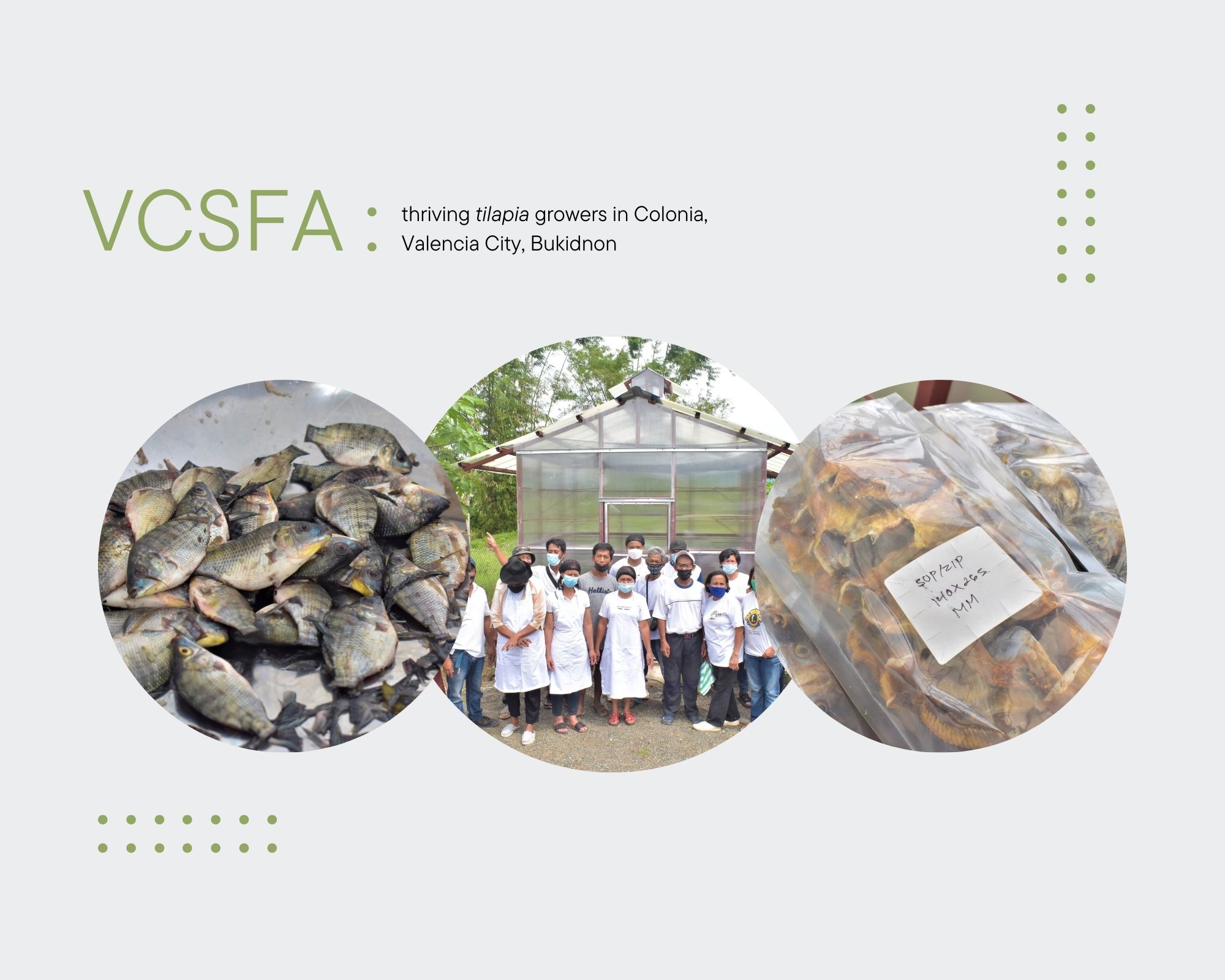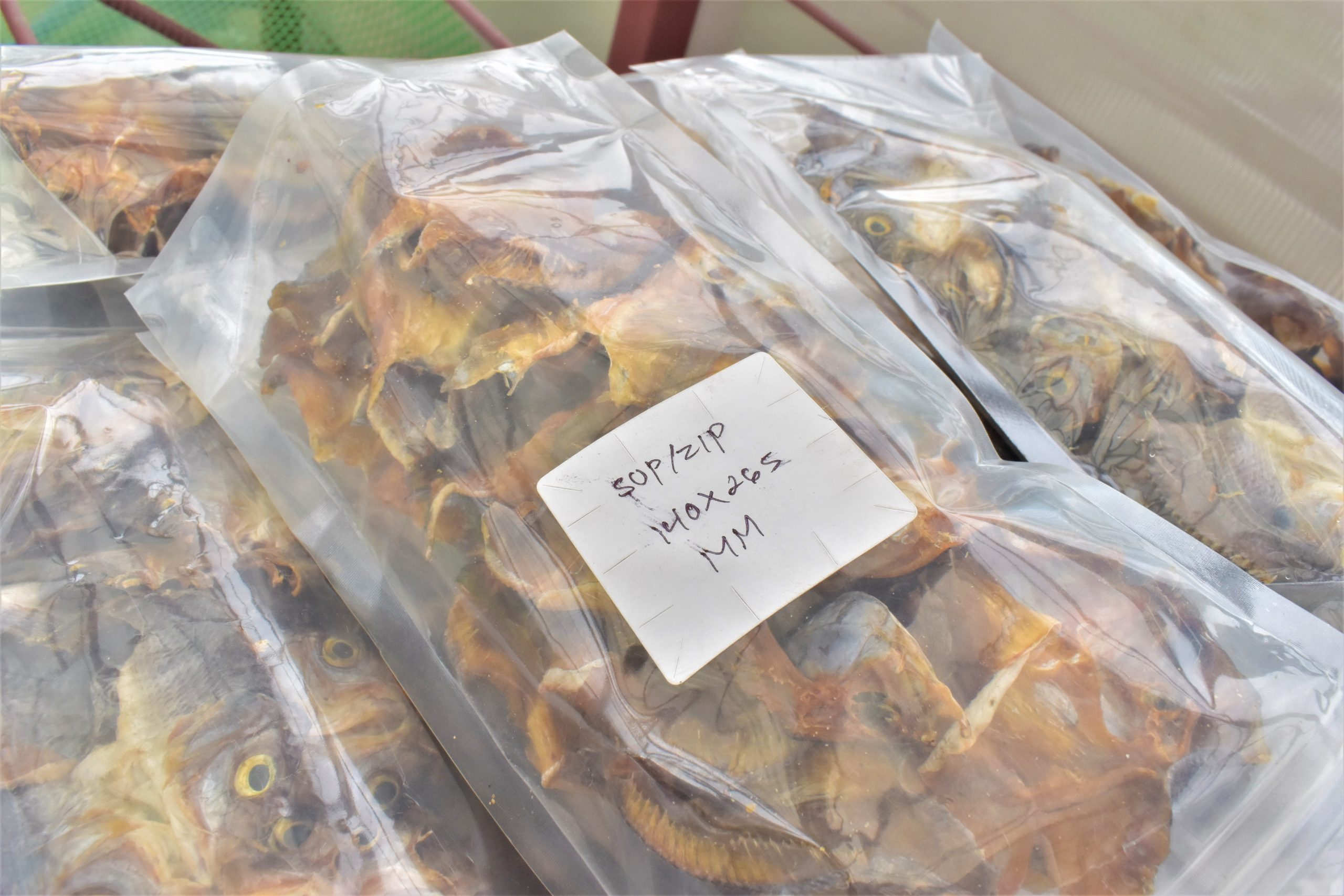Tilapia farming in pond
Cultivating tilapia in earthen ponds is the most widely used system in Bukidnon for growing the fish to marketable size (350-500 grams; 3-7 fish/kg).
Their farm sites have a structure to control water flow in and out. Ponds are constructed on land with a gentle slope, with a loamy soil type that can hold onto large amounts of water, adequate water supply, proximity to markets and roads, and availability of fingerlings. Further, the community should be safe and any fish farming activity is acceptable.
To provide an ideal environment for their fish, after each cycle, the group first sun-dried the bottom of their ponds to get rid of unwanted organisms and stabilize the soil. The water potential hydrogen (acidity level) is maintained at 6.5-8.5 pH. Outside of this range, the fish can stress out and weaken their immune system.
Before they release the fingerlings, they make sure that the stocking density is correct for the pond. Overpopulation will promote a higher chance that the fish will compete for food and living space, which can hinder their growth.
These procedures have been the practice of 30 mixed-crop farmers in barangay Colonia, Valencia City, Bukidnon who grouped themselves as Valencia City SAAD Fisherfolks Association (VCSFA) in 2018 chaired by Mr. Hernando Panis.
Each beneficiary’s particular pond area at 300 to 500 square meters provided them Php 1,000 to 50,000 gross income per cropping which helped in their daily expenses.

It was in 2018 when the Department of Agriculture – Special Area for Agricultural Development (DA-SAAD) Program was introduced to the locals in Valencia City through the Bureau of Fisheries and Aquatic Resources Northern Mindanao (Region 10). To aid the group and address insufficient capital and production maintenance such as fingerlings and feeds threaten the livelihood’s sustainability, they were picked to receive inputs for Tilapia in Pond Culture Project worth Php 1,500,771.50.
Aside from fishery inputs, they were also provided with a series of training in pond grow-out technology, tilapia satellite hatchery fingerlings production, tilanggit processing, values formation, feed formulation, leadership skill, entrepreneurship, packaging and labeling, and business plan preparation (Table 1).
The whole project consists of packages from fingerlings to postharvest processing.Table 1. Fishery livelihood inputs received from 2018 to 2021
| Year | Project | Total Beneficiaries | Unit Cost (Php) |
Total Cost (Php) |
| 2018 | AquaCPAR Technology | 20 | 9,681.00 | 193,620.00 |
| Tilapia Culture in Pond | 10 | 6,831.00 | 68,310.00 | |
| Satellite Hatchery | 30 | 84,396.00 | ||
| Processing Materials | 30 | 39,740.25 | ||
| 2019 | AquaCPAR Technology | 20 | 7,608.00 | 152,160.00 |
| Tilapia Culture in Pond | 10 | 5,350.00 | 53,500.00 | |
| Satellite Hatchery | 30 | 29,225.00 | ||
| Feed Formulation Equipment | 30 | 72,500.00 | ||
| Feed Formulation Shed | 30 | 81,755.00 | ||
| Fish Processing Shed | 30 | 150,000.00 | ||
| Fish Processing Equipment | 30 | 18,415.00 | ||
| 2020 | AquaCPAR Technology | 30 | 8,245.00 | 247,350.00 |
| Tilapia Culture in Pond | 30 | 4,660.00 | 139,800.00 | |
| 2021 | Solar Dryer | 30 | 170,000.00 | |
| Total | 1,500,771.25 | |||
SAAD Project Implementation and Management
Through SAAD and BFAR 10’s Technological Outreach Station (TOS), members of VCSFA were given 60,000 fingerlings to be cultivated in two methods: Aquaculture Community-Based Participatory Action Research (AquaCPAR) Technology and Tilapia Culture in Pond (TCiP).
In AquaCPAR, 20 individuals are assigned to each grow 2,500 fingerlings at a pond area of 300-500sqm. After three months of the culture period, female fishes are harvested for tilanggit processing while the remaining male tilapia are grown until five months for commercial purposes.
For TCiP, 10 individuals each with a 300sqm pond area grow 1,000 fingerlings until they reach marketable size in five months.
To determine the growth rate of the fish, the group conducts monthly sampling, checks if there are symptoms of underfeeding and diseases, removes weeds or floating aquatic plants, and monitors the gate occasionally to prevent the entry of other fish species and avoid loss of stock. They also maintained the proper diet of fish, feeding them twice a day (morning and afternoon) to produce fast-growing tilapia with high nutritional value.
While pond culture is a wonderful spawning environment for tilapia resulting in uncontrolled breeding, the members made sure that for the next cropping, they will let the bottom of the pond dry out before the new stocks arrive, in order to kill off any fry and fingerlings that might otherwise interfere with the new production cycle.

After five months of proper care and maintenance, the members reported their individual harvests after the fish reached their marketable size (350-500 grams) and were marketed within Valencia City.
They accumulated a gross income of Php 1,385,200 from selling tilapia at Php 100/kg for both AquaCPAR and TCiP culture (Table 2).Table 2. Accumulated gross income from tilapia farming
| Project | Year | Production | |
| Tilapia Grow-out (kg) |
Total Sales (Php) |
||
| AquaCPAR | 2018 | 635 | 63,500.00 |
| TCiP | 462 | 46,200.00 | |
| AquaCPAR | 2019 | 1,721 | 172,100.00 |
| TCiP | 1,251 | 125,100.00 | |
| AquaCPAR | 2020 | 3,185 | 318,500.00 |
| TCiP | 1,596 | 159,600.00 | |
| AquaCPAR | 2021 | 3,174 | 317,400.00 |
| TCiP | 1,828 | 182,800.00 | |
| Total | 13,852 | 1,385,200.00 | |
In both methods, the prolific breeding characteristic of tilapia results in size variation at harvest, which is not ideal for the market. So, aside from selling their fresh fish harvest, the group also engaged in tilanggit production to help reduce loss and wastage. Small size tilapia with an average body weight of 50g/pc are dried and packed, commanding a high market price of Php 1,000/kg.
The association has recorded Php 309,625 gross income from tilanggit (Table 3).Table 3. Income from tilanggit production
| Year | Tilanggit (kg) |
Total Sales (Php) |
| 2018 | 87 | 87,000.00 |
| 2019 | 120 | 120,000.00 |
| 2020 | 94 | 94,000.00 |
| 2021 | 86.25 | 8,625.00 |
| Total | 387.25 | 309,625.00 |
Mr. Elly Lagos shared that for every cropping, each member is required to give 50kg of tilapia (2-3 months old) for processing. The product is sold within the community but the group is hoping to supply it to the whole province of Bukidnon.
With this, tilapia farming in upland areas becomes more practical and profitable.
“Gwapo kaayo ang impact sa project sa BFAR, ayos kaayo! Nakapalit ko’g mga gamit, naka-tukod ko’g payag. Ang average gyud namo nga ma-income kada harvest kay naa sa Php 30,000. Pasalamat gyud kaayu mi kay naa ning BFAR, sa management wala gyud ko’y maisturya kundi salamat kaayu sa panalangin na inyong gidala diri sa amo,” said Mr. Lagos.
(The impact of the BFAR project is good. I was able to buy materials for my nipa hut. The average income that we get every harvest is Php 30,000. We are thankful for BFAR and the management, we don’t have anything to say but thank you for the blessings you brought to us).
Ever since he received the project from SAAD, Mr. Lagos became an advocate of tilapia farming in their community. He encouraged the farmers to grow it even in their backyard as it will increase family income because it is a good quality food suitable for processing into dried, smoked, or salted dried, and most of all, it grows very fast and reaches the marketable size in less than 6 months.
“Ang purpose biya gyud sa pagpangisda kay panud-an, dili pangwarta. Pero kini karon naa nata’y panud-an, makapangwarta pa ta. Mao na ang mga miyembro nako sa asosasyon, malipay kay katung mga naay fish pond ako man tung gina-suroy sila, akong tan-awn og maayo bah pagka-gama sa ilang fishpond. Limpyuhi og sakto, kugihi, ang tubig nindot kai ang tubig usa na siya sa maka-apekto sapangunod sa isda,” said Mr. Lagos, sharing how he motivates the farmers and fisher in their areas to culture tilapia.
(The main purpose for fishing is for us to have our viand, not income. But the project provided us both. That is why the members of the association are happy. I visited their ponds and see if it was properly constructed. I would advise them to clean it regularly and maintain good water quality because a pond with good water will produce more and healthier fish).

Each member is obliged to pay the Php 50 membership fee and another Php 50 for monthly dues. Also, from the gross income per cropping, they also have to give Php 500 per cropping to the association serving as the group’s available fund, saved for the subsequent cropping expense.
“Parte sa tilanggit, paliton namu ang ilahang produkto (sa individual member) for 100 ang kilo, ibaligya namo sa association dayun ang profit kay mahimong pondo namo sa association,” shared Mr. Hernando Panis, the association president, referring to the group’s tilanggit production.
(For the tilanggit, the association will buy the individual members’ product for Php 100/kg of fresh tilapia, then we consolidate it, and the profit will be deposited to our savings account).Enterprise development
With the feed formulation equipment and shed provided by the program, the group is planning to produce their own feeds for tilapia to minimize the cost of buying commercial feeds. Feed processing involves grinding of raw materials, sieving, weighing, mixing, pelleting, drying, and storage. They will also allow other fisherfolk to buy from their feed composition from raw materials like fish meal, rice bran, copra meal, and cassava.
With that cost reduction, they can expand their areas from 300 to 500sqm and 600 to 1,000sqm.
They will also increase their tilanggit production to ensure project sustainability, with the hope to meet all the requirements for Cooperative Development Authority (CDA) application for them to be recognized as a cooperative. ###
Writer: Jennifer A. Valcobero, DA-SAAD NPMO Public Relations and Communications Officer
Sources of Photos and Data: BFAR 10, PFO Bukidnon















Comments (0)